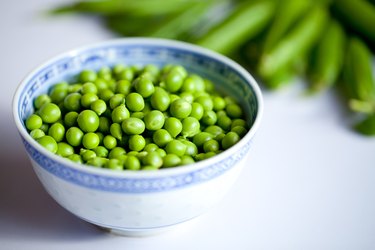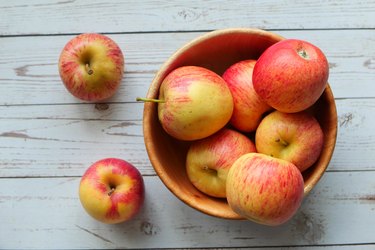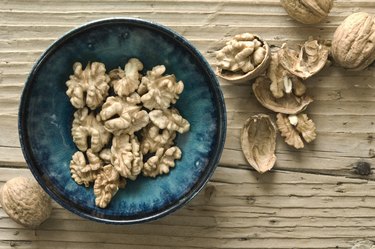
Want to give peas a chance — but find them hard to digest? There are a few different reasons the little green orbs can make your stomach uncomfortable. Here are some of the most common causes and how you can keep peas on your plate without any problems.
1. Peas Are High in Fiber
Video of the Day
Most of us think of peas as a vegetable. But they're actually part of the legume family, along with foods like lentils, chickpeas, soybeans and peanuts. And like other legumes, peas are packed with fiber: One cup serves up just over 8 grams of fiber or 31 percent of what you need for the day, per the USDA.
Video of the Day
All that fiber is beneficial: It supports your digestive health and help you stay fuller longer. But if you're not used to eating high-fiber foods, a big helping of peas might leave you bloated, gassy, crampy or even constipated.
That fiber content is the reason why you might notice peas in your poop too. The insoluble fiber in peas passes through the gut without getting digested, which means whole or partial pieces can end up in your stool, says Supriya Rao, MD, a board-certified gastroenterologist with Integrated Gastroenterology Consultants in Chelmsford, Massachusetts.
It's not a sign that anything's wrong, but it may be a good idea to focus on chewing your food more thoroughly before swallowing, per the Mayo Clinic.
Fix it: Try adding peas or other fibrous foods to your diet more gradually rather than having a big helping all at once. That will give your digestive system time to adjust to the roughage, which can reduce symptoms like gas and bloating, Dr. Rao says. Drink plenty of water too: The fiber passing through your gut will absorb the H20, making your stool softer and easier to pass.
2. They're High In FODMAPs Too
FODMAPs, which stands for fermentable oligo-saccharides, disaccharides, monosaccharides and polyols, are carbohydrates that quickly change from sugar to gas and chemicals in the gut. For some people, eating high FODMAP foods can cause digestive symptoms like bloating, cramping, nausea or diarrhea, per the American College of Gastroenterology.
Many vegetables and legumes contain FODMAPs, including peas. (Other common culprits include leeks, onions, broccoli, artichokes and asparagus.) So if you're FODMAP-sensitive, eating large amounts might make you uncomfortable.
Fix it: FODMAPs are in a lot of foods. Temporarily cutting them out of your diet, elimination-style, can help you figure out which high-FODMAP foods are problematic for you. Then you can gradually reintroduce peas and other FODMAP-rich foods into your diet one at a time. If you notice one food in particular makes you uncomfortable, you'll know to avoid it or only eat it in small amounts.
3. Peas Can Irritate IBS or Other GI Problems
Having irritable bowel syndrome (IBS) might make you more prone to GI problems from peas. Many people with IBS are sensitive to FODMAPs, and some also find that eating large amounts of fiber can cause discomfort, according to the American College of Gastroenterology. FODMAPs can also be problematic for people with irritable bowel disease, celiac disease and small intestinal bacterial overgrowth (SIBO).
Fix it: Low-FODMAP diets may make it easier to manage many GI conditions. For instance, up to 86 percent of patients with IBS who followed a low-FODMAP eating plan noticed an improvement in their GI symptoms, according to a June 2016 review published in Clinical and Experimental Gastroenterology. Many people with IBD can reap similar benefits, per a January 2022 European Journal of Nutrition review.
So if you suspect peas or other FODMAP-rich foods are an issue, talk with your gastroenterologist or dietitian about trying an elimination diet.
4. Peas Can Be an Allergen
It's possible to be allergic to peas, and some people with peanut allergies can be sensitive to all legumes, including peas, as well, according to the American Academy of Allergy Asthma & Immunology (AAAAI). And while most people think of reactions to food allergens in terms of hives or trouble breathing, it's also common to experience abdominal symptoms like cramping, nausea, vomiting or diarrhea.
Fix it: If you experience allergic reaction-like symptoms after eating peas, consult an allergist. They can conduct a simple test to confirm your allergy.
Warning
Allergic reactions can lead to anaphylaxis, a rare but life-threatening condition marked by shortness of breath, throat tightness, swelling, dizziness or loss of consciousness. If you or someone else experiences symptoms of anaphylaxis, call 911 immediately.
5. Peas Contain Lectins
Peas aren't typically eaten raw. But if you happened to pop a bunch of uncooked peas into your mouth, you might notice that you get a little bloated or gassy — or even feel nauseous, vomit or have diarrhea, according the Harvard Health Publishing. That's because raw legumes like peas, lentils and chickpeas are high in lectins, naturally occurring toxins that help protect the plants from being eaten by animals.
Fix it: Just cook your peas. Lectins can cause GI discomfort and may interfere with the absorption of nutrients when consumed raw. But cooking neutralizes the compounds, so they won't mess with your stomach, Dr. Rao says.
- Mayo Clinic: "Undigested food in stool: What does it mean?"
- American College of Gastroenterology: "Low-FODMAP Diet"
- Clinical and Experimental Gastroenterology: "Efficacy of the low FODMAP diet for treating irritable bowel syndrome: the evidence to date"
- European Journal of Nutrition: "FODMAPs, inflammatory bowel disease and gut microbiota: updated overview on the current evidence"
- American Academy of Allergy Asthma & Immunology: "Pea allergy and peanut allergy"
- Harvard Health Publishing: "Lectins"
- USDA: "Cooked Green Peas"
Is this an emergency? If you are experiencing serious medical symptoms, please see the National Library of Medicine’s list of signs you need emergency medical attention or call 911.


